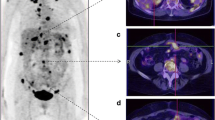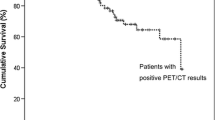Background and Purpose:
The follow-up of epithelial ovarian cancer (OCA) consists of clinical investigation, sonography, and tumor markers (TMs), especially CA 125. If tumor recurrence is suspected, other imaging modalities including positron emission tomography (PET) with 18F-deoxyglucose (FDG) are often used. While there is still no consensus about the method of choice and the timing of its application, this study aims to find a TM threshold at which a PET would be appropriate.
Material and Methods:
A total of 90 PET studies and the associated CA 125 values (normal value < 35 U/ml) were available in 71 patients during the follow-up after primary therapy for OCA. In 48 studies a CEA value (normal value < 3 ng/ml) was also available. The results of PET imaging were related to the level of TM increase.
Results:
In 23/90 studies the PET scan was normal. These patients had a median CA 125 of 13.3 U/ml (range 4.2–168 U/ml). In 67/90 studies the PET indicated a potential recurrence of OCA and the median CA 125 was 166.7 U/ml (range 13.3–4,060 U/ml). The TM levels were significantly different (p < 0.001, U-test). With one exception, there were no normal PET scans above CA 125 levels of 30 U/ml; between 20 and 30 U/ml PET was positive in 4/7 studies.
Conclusion:
In suspected recurrence of OCA, if imaging modalities are to be used, an FDG PET may be considered. Since the costs of this investigation are high, it should be restricted to clinical situations where it is likely to be most effective. In this study a PET indication is worthwhile at CA 125 levels of approximately 30 U/ml.
Hintergrund und Ziel:
Patientinnen mit epithelialen Ovarialkarzinomen (OCA) werden durch regelmäßige Bestimmungen der Tumormarker CA 125 und CEA verlaufskontrolliert. Bei Rezidivverdacht hat sich hier die 18F-Desoxyglucose-Positronenemissionstomographie (FDG-PET) als eine sensitive und auch spezifische Methode etabliert. In dieser Studie soll untersucht werden, ob sich der Einsatz der PET in Abhängigkeit von der Höhe des CA-125-Spiegels an einem Schwellenwert orientieren kann.
Material und Methodik:
Es wurden insgesamt 90 PET-Studien von 71 Patientinnen in die Untersuchung eingeschlossen, bei denen der aktuelle CA-125-Wert (Normalwert < 35 U/ml) vorlag. Bei 48 Studien stand zusätzlich der CEA-Wert (Normalwert < 3 ng/ml) zur Verfügung.
Ergebnisse:
In 23/90 Untersuchungen lag in der PET ein unauffälliger Befund vor. Diese Patientinnen wiesen einen medianen CA- 125-Spiegel von 13,3 U/ml auf (Spannweite 4,2–168 U/ml). In 67/90 Studien konnte in der PET ein tumorsuspekter Befund dargestellt werden. Der mediane CA-125-Spiegel lag hier bei 166,7 U/ml (Spannweite 13,3–4 060 U/ml). Beide Gruppen unterschieden sich hinsichtlich der Tumormarkerspiegel signifikant (p < 0,001, U-Test). Mit einer Ausnahme wurden dabei oberhalb eines CA-125-Spiegels von 30 U/ml keine normalen PET-Befunde mehr erhoben. Im Bereich zwischen 20 und 30 U/ml lieferte die PET in vier von sieben Fällen den Nachweis einer rezidivsuspekten Lokalisation.
Schlussfolgerung:
Im Fall eines Tumormarkeranstiegs in der Verlaufskontrolle des OCA sollten die Möglichkeiten der FDG-PET frühzeitig berücksichtigt werden. Die PET liefert dabei offenbar in Abhängigkeit von der Höhe des CA-125-Spiegels auf die Tumorlokalisation hinweisende Befunde, wobei die PET überwiegend bereits bei Werten zwischen 20 und 30 U/ml positive Befunde erbringt und ab einem Schwellenwert von 30 U/l nahezu bei jeder Patientin einen Rezidivhinweis darstellen kann.
Similar content being viewed by others
Author information
Authors and Affiliations
Corresponding author
Rights and permissions
About this article
Cite this article
Menzel, C., Döbert, N., Hamscho, N. et al. The Influence of CA 125 and CEA Levels on the Results of 18F-Deoxyglucose Positron Emission Tomography in Suspected Recurrence of Epithelial Ovarian Cancer. Strahlenther Onkol 180, 497–501 (2004). https://doi.org/10.1007/s00066-004-1208-3
Received:
Accepted:
Issue Date:
DOI: https://doi.org/10.1007/s00066-004-1208-3




